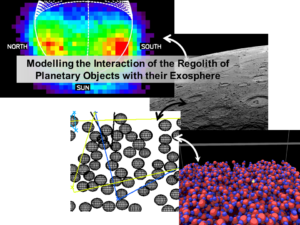Abstract
When meteoroids, solar radiation and solar wind impact onto the surfaces of Mercury and the Moon, they can release many volatile species, producing weak atmospheres – surface bounded exospheres – in the process. Recent measurements (e.g., LADEE, LRO, MESSENGER, Chandrayaan-1 and ground-based observations) provided evidence of atmospheric variation with local time. Other measurements suggest variations of adsorbed water on the lunar surface with local time. These measurements indicate the necessity of considering how gases interact with the uppermost surface on a microphysical scale if we wish to understand macroscopic exospheric processes. For instance, lunar volatiles (e.g., argon and methane), which freeze out at night, do not sharply outgas at sunrise. Methane itself peaks about one hour of local time past the dawn terminator, and recent analysis of the NASA MESSENGER mission and ground-based dataset have revealed a curious cycle of sodium, with periodic afternoon enhancements of exospheric sodium that current models cannot explain. The proposed multi-disciplinary international team, consisting of partners from the US, France, Italy, Switzerland and Germany, will create higher-fidelity physical models of gas trapping within the first top few centimeters of soil and how this trapping produces complex feedback cycles observed in the atmosphere. The proposed work will combine data from both laboratory and spacecraft measurements with diverse modelling efforts that interconnect the surface and atmosphere. Our group has recognized the benefit of combining these independent research threads during the ISSI Workshop entitled “Surface Bounded Exospheres and Interactions in the Solar System”, held in 2020.

